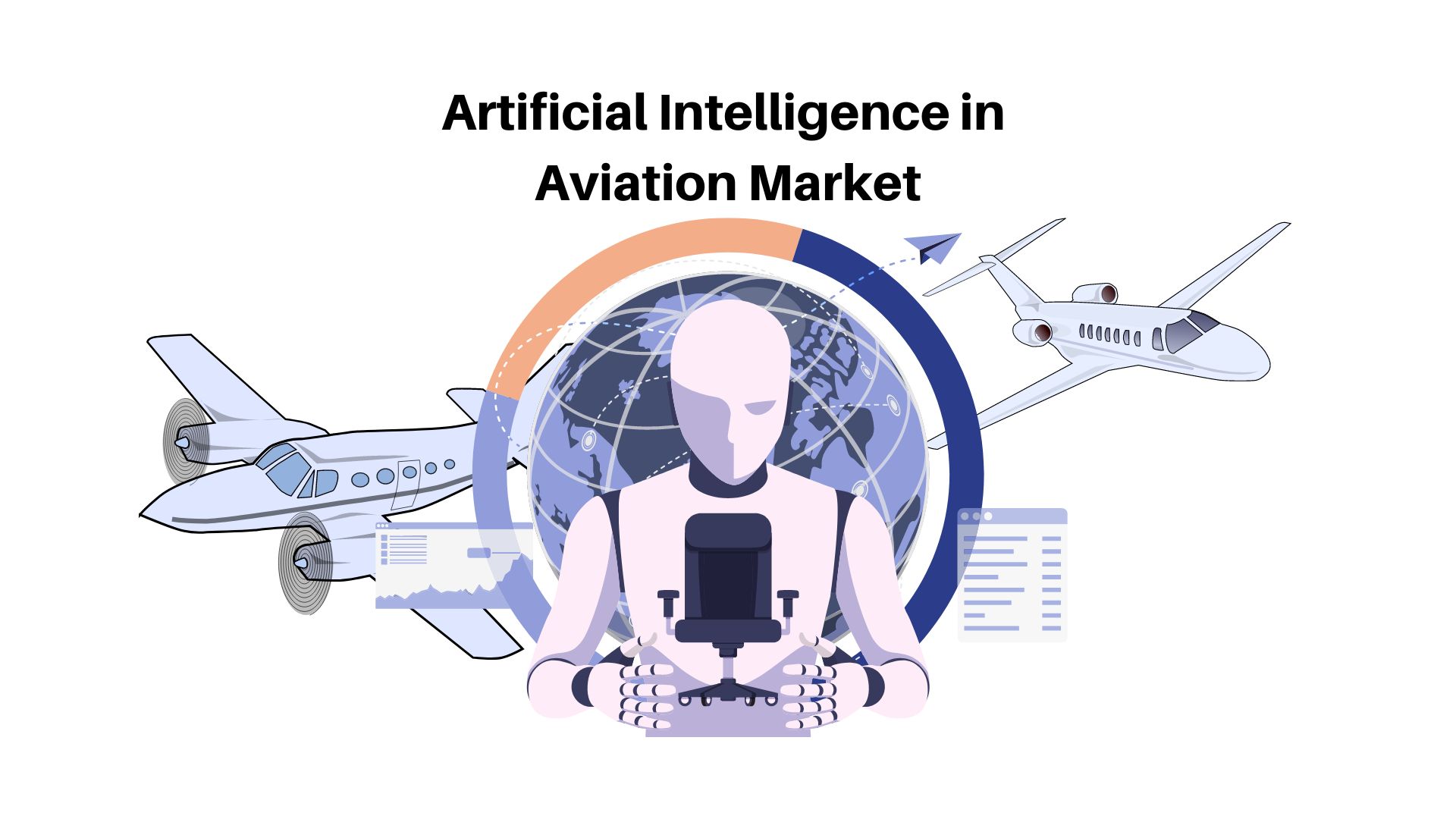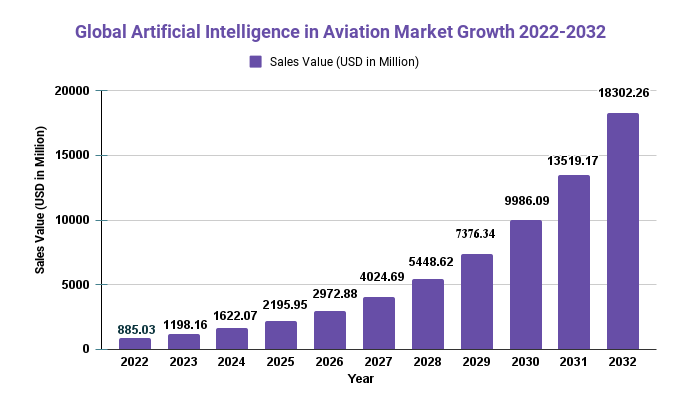CAGR of 35.38% Artificial Intelligence in Aviation Market to Gain USD 18,302.26 Mn in 2032

Page Contents
Published Via 11Press: The global artificial intelligence in aviation market size is expected to be worth around USD 18,302.26 Mn by 2032 from USD 885.03 Mn in 2022, growing at a CAGR of 35.38% during the forecast period from 2022 to 2032.
Artificial intelligence (AI) in aviation is growing rapidly, as this technology promises to enhance safety, efficiency, and passenger experience. One of the key applications of AI in aviation is predictive maintenance, which uses machine learning algorithms to analyze data from aircraft sensors and anticipate when repairs will be necessary. This helps airlines reduce costs, enhance safety, and minimize downtime.
Another vital application of AI in aviation is air traffic management. By employing algorithms to analyze data from radars, sensors, and other sources, air traffic controllers can more accurately forecast traffic flows and reduce congestion in the skies. AI can also be utilized to enhance passenger experiences by providing tailored recommendations for in-flight entertainment and food, as well as faster boarding processes.
Overall, the use of AI in aviation is expected to expand over the coming years as airlines and other industry players strive to enhance efficiency, safety, and customer experience.
Request For Sample Report Here: https://market.us/report/artificial-intelligence-in-aviation-market/request-sample/

Key Takeaways
- The adoption of AI in the aviation industry is growing rapidly, with airlines, airports, and other players using it to enhance safety, efficiency, and customer experience.
- AI technologies such as predictive maintenance, air traffic management, and passenger experience optimization are revolutionizing the aviation industry.
- North America and Europe are the primary markets for AI in aviation, with emerging opportunities throughout the Asia Pacific, the Middle East & Africa, and Latin America.
- Data quality, regulatory adherence, cost efficiency, workforce changes, ethical concerns, and integration are some of the obstacles facing AI adoption in aviation.
- AI in aviation offers several potential benefits, such as enhanced safety, increased efficiency, enhanced customer experience, cost savings, new revenue streams, and technological breakthroughs.
Overall, the adoption of AI in aviation presents both challenges and opportunities. However, the trend toward greater use of AI is expected to persist over the coming years as companies strive to enhance safety, efficiency, and customer experience within this rapidly transforming industry.
Regional Analysis
- North America is the leading market for AI in aviation, with the US leading the charge in terms of developing and applying these technologies. Major players in this region include Boeing, GE Aviation, and Honeywell Aerospace.
- Europe is a major player in the aviation sector, with major firms such as Airbus, Rolls-Royce, and Safran driving innovation there. Additionally, the EU is investing heavily in AI research and development.
- Asia Pacific is rapidly becoming a hub for AI in aviation, with countries like China and Japan investing heavily in the research and development of these technologies. Furthermore, major aviation firms such as Airbus and Boeing are headquartered here.
- Middle East & Africa are rapidly becoming emerging markets for AI in aviation, with countries like the United Arab Emirates investing heavily in this technology. Major players in this region include Emirates Airlines and Etihad Airways.
- Latin America is a small market for AI in aviation, there are signs of development. Brazil, home to Embraer – one of the world's largest aircraft manufacturers – is investing in developing AI technologies for this sector.
- Overall, AI adoption in aviation is a global trend with companies and governments around the world investing in research and development of AI technologies to enhance safety, efficiency, and customer experience within this sector.
Drivers
Improved Safety One of the primary drivers of AI adoption in aviation is improved safety. AI can analyze vast amounts of data from aircraft sensors, weather patterns, and other sources to detect potential safety issues and alert pilots and air traffic controllers. This can help prevent accidents and improve overall safety. Increased Efficiency AI can also help improve the efficiency of aviation operations. For example, predictive maintenance can help airlines reduce downtime and optimize maintenance schedules, while AI-powered air traffic management can reduce congestion and delays. Cost Savings The use of AI can lead to significant cost savings for airlines, through reduced maintenance costs, more efficient operations, and better fuel management.
Enhanced Passenger Experience AI can also be used to provide personalized recommendations for in-flight entertainment and food, as well as more efficient boarding processes. This can improve the overall passenger experience and help airlines attract and retain customers. Technological Advancements Advances in AI technology, including machine learning and natural language processing, have made it easier and more affordable for airlines to implement AI solutions.
Overall, the drivers of AI adoption in aviation are closely linked to the industry's goals of improving safety, efficiency, and customer experience while reducing costs. As these goals become increasingly important in the highly competitive aviation industry, the use of AI is expected to continue to grow.
Restraints
High Costs Implementing AI systems can be expensive, especially for smaller airlines or those with limited resources. This can be a significant barrier to adoption, as the initial investment may be too high for some companies. Data Quality AI relies heavily on high-quality data to produce accurate results. However, data in the aviation industry can be complex and difficult to collect and analyze, which can limit the effectiveness of AI systems. Regulatory Barriers The use of AI in aviation is subject to strict regulations, particularly when it comes to safety and security. This can create barriers to adoption, as airlines must ensure that their AI systems comply with all relevant regulations.
Workforce Changes The implementation of AI in aviation can lead to significant changes in the workforce, as some jobs may become automated or require new skills. This can be a challenge for airlines that must balance the need for automation with the need to maintain a skilled and experienced workforce. Ethical Concerns The use of AI in aviation raises ethical concerns, particularly when it comes to issues such as privacy, data security, and algorithmic bias. These concerns can limit the adoption of AI, as airlines must ensure that their systems are transparent and ethical.
Overall, these restraints highlight the need for careful planning and implementation of AI systems in the aviation industry. While the benefits of AI are clear, airlines must also be aware of the challenges and work to address them in order to fully realize the potential of AI in aviation.
Opportunities
Enhanced Safety AI can enhance aviation safety by analyzing massive amounts of data from aircraft sensors, weather patterns, and other sources to detect potential safety issues and alert pilots and air traffic controllers. This helps prevent accidents and boost overall security levels. Increased Efficiency AI-powered predictive maintenance and air traffic management can enhance aviation operations, leading to reduced downtime, optimized maintenance schedules, and less congestion, and delays. Improved Customer Experience AI can be employed to offer tailored recommendations for in-flight entertainment and food, as well as more efficient boarding processes. This enhances the passenger experience and helps airlines attract and retain customers.
Cost Savings The use of AI can result in significant cost savings for airlines, through reduced maintenance expenses, more efficient operations, and improved fuel management. New Revenue Streams The use of AI opens up new revenue opportunities for airlines and airports such as selling data or analytics services. Technological Advancements Recent advances in AI technology such as machine learning and natural language processing are making it simpler and more affordable for airlines to implement AI solutions.
Overall, AI offers aviation a host of opportunities – from improved safety and efficiency to enhanced customer experiences and new revenue streams. As such, its adoption by the industry is expected to accelerate over the coming years.
Challenges
Data Quality AI relies heavily on high-quality data to produce accurate results. However, data in the aviation industry can be complex and difficult to collect and analyze, which can limit the effectiveness of AI systems. Regulatory Compliance The use of AI in aviation is subject to strict regulations, particularly when it comes to safety and security. Airlines must ensure that their AI systems comply with all relevant regulations, which can be a complex and time-consuming process. Cost The implementation of AI systems can be expensive, especially for smaller airlines or those with limited resources. This can be a significant barrier to adoption, as the initial investment may be too high for some companies.
Workforce Changes The adoption of AI in aviation can lead to significant changes in the workforce, as some jobs may become automated or require new skills. Airlines must balance the need for automation with the need to maintain a skilled and experienced workforce. Ethical Concerns The use of AI in aviation raises ethical concerns, particularly when it comes to issues such as privacy, data security, and algorithmic bias. These concerns can limit the adoption of AI, as airlines must ensure that their systems are transparent and ethical. Integration Integrating AI systems with existing aviation infrastructure can be a challenge, especially when it comes to legacy systems that may not be compatible with new technologies.
Overall, these challenges highlight the need for careful planning and implementation of AI systems in the aviation industry. While the benefits of AI are clear, airlines must also be aware of the challenges and work to address them in order to fully realize the potential of AI in aviation.
Recent Development
- In July 2021, Tata Power entered into a partnership with Autogrid to launch a residential demand response program and increase consumer acceptance of this type of behavior.
- In June 2020, an AI company named SparkCognition joined forces with Boeing to form SkyGrid, creating an aerial operating system designed for the next generation of autonomous aviation.
Key Market Segments
Type
- Hardware
- Software
- Service
Application
- Virtual Assistants
- Smart Maintenance
Key Market Players
- Airbus
- Amazon
- Boeing
- Garmin
- GE
- IBM
- Intel
- IRIS Automation
- Kittyhawk
- Lockheed Martin
- Micron
- Microsoft
- Neurala
- Northrop Grumman
- Nvidia
- Pilot AI Labs
- Samsung Electronics
- Thales
- Xilinx
Report Scope
| Report Attribute | Details |
| The market size value in 2022 | USD 885.03 Mn |
| Revenue forecast by 2032 | USD 18,302.26 Mn |
| Growth Rate | CAGR Of 35.38% |
| Regions Covered | North America, Europe, Asia Pacific, Latin America, and Middle East & Africa, and the Rest of the World |
| Historical Years | 2017-2022 |
| Base Year | 2022 |
| Estimated Year | 2023 |
| Short-Term Projection Year | 2028 |
| Long-Term Projected Year | 2032 |
Contact us
Contact Person: Mr. Lawrence John
Market.us (Powered By Prudour Pvt. Ltd.)
Tel: +1 718 618 4351
Send Email: [email protected]
FAQ.
Artificial Intelligence in Aviation Market is studied from 2017 - 2032.
Artificial Intelligence in Aviation Market is growing at a CAGR of 35.38%
Asia Pacific is growing at the highest CAGR over 2022- 2032.
North America holds the highest share in 2022.
Airbus, Amazon, Boeing, Garmin, GE, IBM, Intel, IRIS Automation, Kittyhawk, Lockheed Martin, Micron, Microsoft, Neurala, Northrop Grumman, Nvidia, Pilot AI Labs, Samsung Electronics, Thales, Xilinx
The team behind market.us, marketresearch.biz, market.biz and more. Our purpose is to keep our customers ahead of the game with regard to the markets. They may fluctuate up or down, but we will help you to stay ahead of the curve in these market fluctuations. Our consistent growth and ability to deliver in-depth analyses and market insight has engaged genuine market players. They have faith in us to offer the data and information they require to make balanced and decisive marketing decisions.



